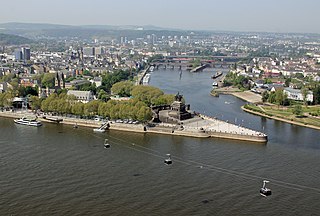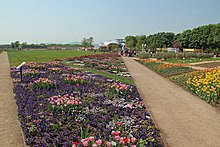
Rhineland-Palatinate is a western state of Germany. It covers 19,846 km2 (7,663 sq mi) and has about 4.05 million residents. It is the ninth largest and sixth most populous of the sixteen states. Mainz is the capital and largest city. Other cities are Ludwigshafen am Rhein, Koblenz, Trier, Kaiserslautern, Worms, and Neuwied. It is bordered by North Rhine-Westphalia, Saarland, Baden-Württemberg and Hesse and by France, Luxembourg and Belgium.

Koblenz is a German city on the banks of the Rhine and the Moselle, a multinational tributary.

The Rhine Gorge is a popular name for the Upper Middle Rhine Valley, a 65 km (40 mi) section of the Rhine between Koblenz and Rüdesheim in the states of Rhineland-Palatinate and Hesse in Germany. It was added to the UNESCO list of World Heritage Sites in June 2002 because of its beauty as a cultural landscape, its importance as a route of transport across Europe, and the unique adaptations of the buildings and terraces to the steep slopes of the gorge.

Ehrenbreitstein Fortress is a fortress in the German state of Rhineland-Palatinate, on the east bank of the Rhine where it is joined by the Moselle, overlooking the town of Koblenz.

Middle Rhine is the section of the Rhine between Bingen and Bonn in Germany. It flows through the Rhine Gorge, a formation created by erosion, which happened at about the same rate as an uplift in the region, leaving the river at about its original level, and the surrounding lands raised. This gorge is quite deep, about 130 metres (430 ft) from the top of the rocks down to the average water-line.

The Cologne Cable Car is a gondola lift that runs across the river Rhine in Cologne, Germany. It connects the two banks of the Rhine at the height of Cologne's Zoo Bridge (Zoobrücke).

The Electorate of Trier was an ecclesiastical principality of the Holy Roman Empire that existed from the end of the 9th to the early 19th century. It was the temporal possession of the prince-archbishop of Trier who was, ex officio, a prince-elector of the empire. The other ecclesiastical electors were the electors of Cologne and Mainz.

The Deutsches Eck is the name of a promontory in Koblenz, Germany, where the Mosel river joins the Rhine. Named after a local commandry of the Teutonic Order, it became known for a monumental equestrian statue of William I, first German Emperor, dedicated in 1897 in appreciation of his role in the unification of Germany. One of many Emperor William monuments raised in the Prussian Rhine Province, it was dismantled on the orders of the French military government immediately after the Second World War, and only the plinth was preserved as a memorial. Following German reunification, a replica of the statue was erected on the pedestal after controversial discussions in 1993. It is today a Koblenz landmark and a popular tourist attraction.
The Bundesgartenschau is a biennial federal horticulture show in Germany. It also covers topics like landscaping. Taking place in different cities, the location changes in a two-year cycle.

Koblenz Hauptbahnhof is a railway station in the city of Koblenz in the German state of Rhineland-Palatinate. It is the focal point of rail transport in the Rhine-Moselle-Lahn area. It is a through station in southern Koblenz built below Fort Großfürst Konstantin and opened in 1902 in the Neustadt, which was built after the demolition of the city walls in 1890. The station replaced two former stations on the Left Rhine railway, which were only 900 m (3,000 ft) apart, and the former Moselle line station. Koblenz-Stadtmitte station opened in April 2011 in the old centre of Koblenz. Koblenz Hauptbahnhof is on the West Rhine Railway and connects to the Moselle line, the East Rhine Railway and to the Lahntal railway. It is used daily by about 40,000 travelers and visitors. In the station forecourt are a bus station and a pavilion.
Mittelrhein is a region (Anbaugebiet) for quality wine in Germany, and is located along a 120 km stretch of river Rhine in the tourist portions of the Rhine region known as Middle Rhine. On the left bank of Rhine, vineyards begin immediately downstream of the Nahe estuary and last until Koblenz. On the right bank, vineyards begin where Rheingau ends and last until 8 kilometers south of Bonn, in the Siebengebirge. Parts of the Rhine Gorge, a UNESCO World Heritage since 2002, make up the southern part of Mittelrhein.

The Electoral Palace in Koblenz, was the residence of the last Archbishop and Elector of Trier, Clemens Wenceslaus of Saxony, who commissioned the building in the late 18th century. In the mid-19th century, the Prussian Crown Prince had his official residence there during his years as military governor of the Rhine Province and the Province of Westphalia. It now houses various offices of the federal government.

The Basilica of Saint Castor is the oldest church in Koblenz in the German state of Rhineland Palatinate. It is located near Deutsches Eck at the confluence of the Rhine and the Moselle. A fountain called Kastorbrunnen was built in front of the basilica during Napoleon's invasion of Russia in 1812. Pope John Paul II raised Saint Castor to a basilica minor on 30 July 1991. This church is worth seeing for the historical events that have occurred in it, its extensive Romanesque construction and its largely traditional furnishings.

Koblenz-Ehrenbreitstein station is the only station on the right (eastern) bank in the city of Koblenz in the German state of Rhineland-Palatinate. It is on the East Rhine railway at the foot of the Ehrenbreitstein hill in the Ehrenbreitstein district, next to the Rhine.
The following is a timeline of the history of Koblenz, Germany.

The Koblenz cable car is an gondola lift that was opened in 2010 in Koblenz, Germany for the Bundesgartenschau the following year. It connects the banks of the river Rhine and the hill plateau next to Ehrenbreitstein Fortress. The cable car system has an 890m length and elevates 112m.

The Westfalenpark is a large public park in Dortmund, Germany. With an area of 70 ha, the park is one of the largest inner-city parks in Europe and is a popular destination for excursions and recreation in North Rhine-Westphalia. The park is situated between the Westfalenstadion, Westfalenhallen, Bundesautobahn 40 and includes the Florianturm. The Emscher valley forms the southern border of the park.
A Regional Garden Show is an exhibition on horticulture that takes place on a regular basis in several German and Austrian states. In Germany, a state horticultural show at the state level is the smaller counterpart to the Bundesgartenschau and the International Horticultural Show, in Austria there is no counterpart so far.

The Philippsburg palace ) was a former Baroque-style palace in Ehrenbreitstein, a district of the city of Koblenz in Germany. It was situated on the banks of the Rhine river, below the Ehrenbreitstein Fortress. Constructed between 1626 and 1632 by Philipp Christoph von Sötern (1567–1652), Prince-Elector of Trier, it served as the main residence of the Archbishops and Prince-Electors of Trier until 1786. The palace had similarities to Schloss Johannisburg in Aschaffenburg, as they have the same architect.

The German Army Memorial at the Ehrenbreitstein Fortress in Koblenz is a war memorial inaugurated in 1972 on behalf of the modern German Army in honor of German Army soldiers who died in the two world wars. Since 2006 it also serves to honor soldiers of the Bundeswehr who have died in peacetime or in operations abroad. It is one of three Memorials of the Armed Forces for each branch of the Bundeswehr, the others being the Laboe Naval Memorial near Kiel and the Luftwaffe Memorial in Fürstenfeldbruck.





















